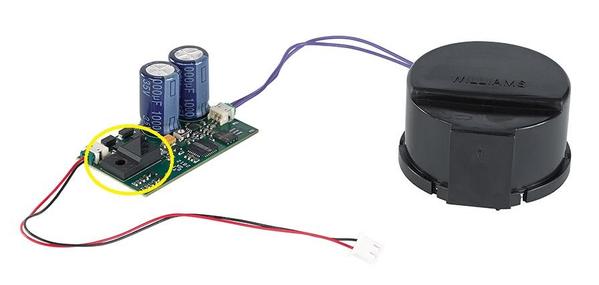Which version do you have?
If something like the above, can you read the marking on the circled part? Some other versions have a similar looking part (3-legged) but standing up. This is likely the voltage regulator chip and its part number would be the first layer of peeling the onion.
You can ballpark capacitor sizing by computing the stored energy required. For example, if the audio power is 2 Watts and you want to sustain this for, say, 1 second (when there's no track voltage), Energy (in Joules) = Power (in Watts) x Time (in sec), so you need 2 Joules of energy.
A capacitor's stored energy = 1/2 x Capacitance (in Farads) x Voltage x Voltage. So, for example, it appears this board has two 1000uF capacitors. Let's say they put them in parallel (2000uF or 0.002 Farads) and they get charged up to 15V which might be typical for running conventional control mode. That's a stored energy of "only" about 1/4 Joules.
So it's no wonder there's not enough on-board energy to sustain a 1 second power loss. And of course that energy must also supply the processor chip other electronics - and there are losses so you can never access all of the theoretical stored energy in the capacitors.
The suggested "super-cap" method is probably where to go because this technology has superior stored-energy density vs. the traditional electrolytic capacitor technology as used in the photo. For about the same size as one of the 1000uF capacitors, you can get a 1 Farad, 5V super-cap for about $3. If charged to 5V, that's a relatively whopping 12.5 Joules of energy which should be sufficient.
There are i's to dot and t's to cross but I think it's do-able.
Ought of curiosity, if you are in neutral and crank up track voltage to, say, 18V when pressing direction, does the sound still cut-out as quickly as if you were at, say, 9V when pressing direction? And/or if you lower the volume (if it's adjustable) can you alter the cut-out time - that is, does sound cut-out as quickly at low volume than full-volume?






